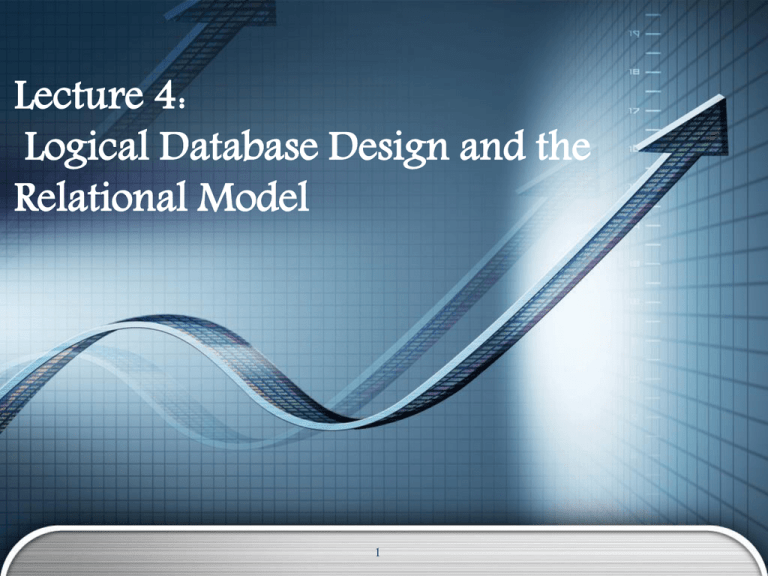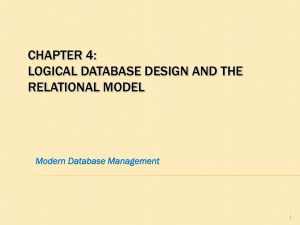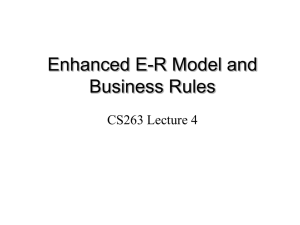Lecture 4 Description
advertisement

Lecture 4: Logical Database Design and the Relational Model 1 Relation A relation is a named, two-dimensional table of data Table consists of rows (records) and columns (attribute or field) Requirements for a table to qualify as a relation: 1. It must have a unique name 2. Every attribute value must be atomic (not multivalued or composite) 2 Cont… 3. Attributes (columns) in tables must have unique names 4. The order of the columns must be irrelevant 5. The order of the rows must be irrelevant 6. Every row must be unique (can’t have two rows with exactly the same values for all their fields) Note: All relations are in 1st Normal Form 3 Correspondence with ER Model 1. Relations (tables) correspond with entity types and with many-to-many relationship types 2. Rows correspond with entity instances and with many-to-many relationship instances 3. Columns correspond with attributes Note: The word RELATION (in relational database) is NOT the same as the word RELATIONSHIP (in ER Model) 4 Key Fields Keys are special fields that serve two main purposes: 1. Primary keys – unique identifiers of the relation in question. 2. Foreign keys – identifiers that enable a dependent relation (on the many side of a relationship) to refer to its parent relation (on the one side of the relationship) Keys can be single or composite 5 Fig 5-3 Schema for four relations (PVFC) 6 Integrity Constraints Domain Constraints – allowable values for an attribute Entity Integrity - no primary key attribute may be null. All primary key fields MUST have data Actions Assertions - business rules 7 8 Integrity Constraints Referential Integrity – rule states that any foreign key value (on the relations of the many side) MUST match a primary key value in the relation of the one side (or the foreign key can be null) 9 Cont… Ex: Delete Rules a. Restrict – don’t allow delete of “parent” side if related rows exist in “dependent” side b. Cascade – automatically delete “dependent” side rows that correspond with the “parent” side row to be deleted c. Set-to-Null – set the foreign key in the dependent side to null if deleting from the parent side = not allowed for weak entities 10 Fig 5-5 Referential Integrity Constraints 11 Fig 5-6 SQL table definitions 12 Transforming EER Diagrams into Relations Mapping Regular Entities to Relations 1. Simple attributes: ER attributes map directly onto the relation 2. Composite attributes: use only their simple component attributes 3. Multivalued attribute: becomes a separate relation with a foreign key taken from the superior entity. 13 Fig 5-8 Mapping a regular entity 14 Fig 5-9 Mapping a Composite Attribute 15 Fig 5-10 Mapping an entity with a multivalued attribute 16 Cont… 4. Mapping Weak Entities - Becomes a separate relation with a foreign key taken from the superior entity Primary key composed of: a. Partial identifier of weak entity b. Primary key of identifying relation (strong entity) 17 Fig 5-11 Ex: Mapping a Weak Entity 18 Cont… 19 Cont… 5. Mapping Binary Relationships a. One-to-Many – Primary key on the one side becomes a foreign key on the many side b. Many-to-Many – Create a new relation with the primary keys of the two entities as its primary key c. One-to-One – Primary key on the mandatory side becomes a foreign key on the optional side 20 Fig 5-12 Ex: Mapping of 1:M Relationship 21 Fig 5-13 Ex: Mapping M:N Relationship 22 Cont… 23 Fig 5-14 Ex: Mapping a 1:1 relationship 24 Cont… 25 Cont… 6. Mapping Associative Entities a. Identifier Not Assigned a.1 Default primary key for the association relation is composed of the primary keys of the two entities (as in M:N relationship) b. Identifier Assigned b.1 It is natural and familiar to end users b.2 Default identifier may not be unique 26 Fig 5-15 Ex: Associative Entity 27 Cont… 28 Fig 5-16 Ex: Mapping an Associative Entity with an Identifier 29 Cont… 30 Cont… 7. Mapping Ternary (and n-ary) Relationships a. One relation for each entity and one for the associative entity b. Associative entity has foreign keys to each entity in the relationship 31 Fig 5-19 Mapping a Ternary Relationship 32 Cont… 33 Cont.. 8. Mapping Supertype/Subtype Relationships a. One relation for supertype and for each subtype b. Supertype attributes (including identifier and subtype discriminator) go into supertype relation c. Subtype attributes go into each subtype; primary key of supertype relation also becomes primary key of subtype relation 34 Cont.., d. 1:1 relationship established between supertype and each subtype, with supertype as primary table 35 Fig 5-20 Supertype/Subtype Relationships 36 Fig 5-21 Mapping Supertype/Subtype Relationships to Relation 37 Data Normalization 1. Primary a tool to validate and improve a logical design so that it satisfies certain constraints that avoid unnecessary duplication of data 2. The process of decomposing relations with anomalies to produce smaller, wellstructured relations 38 Well-Structured Relations 1. A relation that contains minimal data redundancy and allows users to insert, delete, and update rows without causing data inconsistencies 2. Goal is avoid anomalies 2.1 Insertion anomaly – adding new rows forces user to create duplicate data 2.2 Deletion anomaly – deleting rows may cause a loss of data that would be needed for other future rows 39 Cont… 2.3 Modification Anomaly – changing data in a row forces changes to other rows because of duplication General rule of thumb: A table should not pertain to more than one entity type 40 Fig 5-2b Ex: 41 Anomalies: Insertion – can’t enter a new employee without having the employee take a class Deletion – if we remove employee 140, we lose information about the existence of a Tax Acc class Modification – giving a salary increase to employee 100 forces us to update a multiple records 42 Cont… Why do these anomalies exist? Because there are two themes (entity types) in this one relation. These results to data duplication and an unnecessary dependency between the entities. 43 Functional Dependencies and Keys 1. Functional Dependency – the value of one attribute (determinant) determines the value of another attribute 2. Candidate Key: 2.1 Unique Identifier – one of the candidate keys will become the primary key Ex: Perhaps both credit card number and SS# are in the table… in this case both are candidate key 2.2 Each non-key field is functionally dependent on every candidate key 44 Fig 5-22 Steps in Normalization 45 First Normal Form No multivalued attributes Every attribute value is atomic Fig 5-25 is not in 1st Normal Form (multivalued attributes) = it is not a relation Fig 5-26 is in 1st Normal Form All relations are in 1st Normal Form 46 Fig 5-25 INVOICE DATA 47 Fig 5-26 INVOICE relation (1NF) 48 Anomalies in the Table Insertion – if new product is ordered for order 1007 of existing customer, customer data must be reentered, causing duplication Deletion – if we delete the Dining Table from Order 1006, we lose information concerning this item’s finish and price Update – changing the price of product ID 4 required update in several records 49 Cont.. Why do these anomalies exists? Because there are multiple themes (entity types) in one relation. This results in duplication and an unnecessary dependency between the entities 50 Second Normal Form 1NF PLUS every non-key attribute is fully functionally dependent on the ENTIRE primary key Every non-key attribute must be defined by the entire key, not by only part of the key No partial functional dependencies 51 Fig 5-27 Functional dependency diagram for INVOICE 52 Fig 5-28 Removing Partial Dependencies 53 Third Normal Form 2NF PLUS no transitive dependencies (functional dependencies on non-primary-key attributes) Note: This is called transitive, because the primary key is a determinant for another attribute, which in turn is a determinant for a third Solution: Non-key determinant with transitive dependencies go into a new table; non-key determinant becomes primary key in the new table and stays as foreign key in the old table. 54 Fig 5-28 Removing Partial Dependencies 55 - End - 56










